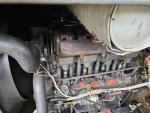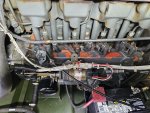handyjay03
Member
- 39
- 18
- 8
- Location
- Louisiana
Doing some PMs on a recently acquired 803A, and couldn't find my small strap wrench to get the fuel/water separator off. Tried removing the generator left side panel between front control panel and side door to get better access, and it turns out, it is all bolts with nuts on the other side of the panel. I figured no problem, I'll just take the top off and get them bolted back up. Well, the top has the same setup. After some head scratching and a break, I spent a few minutes and found the strap wrench that worked to get the fuel/water separator off, but now I/m stuck with a bunch of panels that won't come off and half of the nuts dropped to the bottom of the case. Any trick to get into this thing?
Before swapping the separator, I also did some testing with 5000W heaters. Ammeter was way off (showing ~80% at 19.1A). Going to try cleaning the contacts, but it dropped completely out when I tried adjusting it down. It also wouldn't stay running with any more than 35.5A, so that's something I've got to sort out. The previous owner never ran it hard, so I am trying to work up on load, but it just can't make it past 35.5A without killing the engine after almost two hours of running at that level.
6/22 update: changed thread title for next issue
Before swapping the separator, I also did some testing with 5000W heaters. Ammeter was way off (showing ~80% at 19.1A). Going to try cleaning the contacts, but it dropped completely out when I tried adjusting it down. It also wouldn't stay running with any more than 35.5A, so that's something I've got to sort out. The previous owner never ran it hard, so I am trying to work up on load, but it just can't make it past 35.5A without killing the engine after almost two hours of running at that level.
6/22 update: changed thread title for next issue
Last edited:





